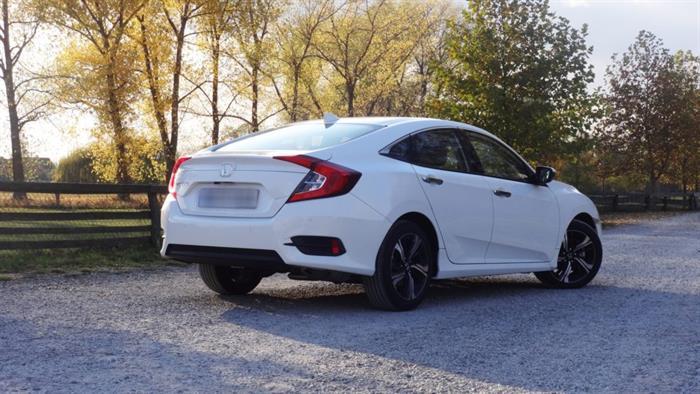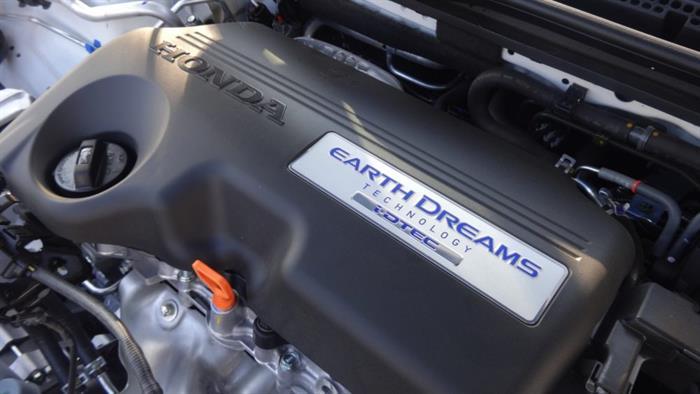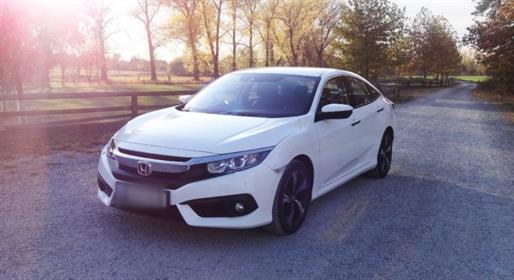The current 10th generation Honda Civic is a car we are already familiar with in our editorial office. The Civic passed our test in both the 4D (sedan) and 5D (hatchback) versions, as well as in one-liter or one-and-a-half-liter gasoline engines.
This time, however, we have a novelty that the Japanese automaker has prepared for us, namely a version with a diesel turbocharged 1.6 i-DTEC engine, so last week we were accompanied by the Civic 4D, which had this engine in combination with a six-speed manual transmission gearbox.

The exterior design of this tenth generation clearly succeeded, Honda opted for a bold, dynamic design and thus created a truly handsome, original and unmistakable vehicle.
Dynamic features and strict horizontal proportions are omnipresent on the car. Its front part is the most dynamic of the entire car, the distinctive chrome mask with the car company logo goes over and overlaps the upper part of the front headlights. On the other hand, in their lower part, we have a line that runs and forms the edge of the entire front bumper, from which it elegantly passes into the front fenders and the entire side part of the car. It is finished only at the point where the rear taillights break.
The side part of the car is pleasantly continuous, the roof gradually descends and very smoothly transitions into the rear trunk lid. A very effective element consists of a pair of bends that start from the front mask over the front hood and then connect to the A-pillars. Thanks to these edges, the bonnet is bent at the edges, giving it a very interesting shape.
The rear taillights are pushed all the way to the sides of the car, their curved shape then extends to the edge of the trunk lid. The rear part of the sedan has very robust and optically stable proportions.
The exterior design of this four-door sedan was simply refined by Honda down to the smallest detail. Its sporty character is clearly legible, moreover, without any harm to the interior space.

The interior of the tenth generation, this is the new wider and longer platform of the car, which offers a really large interior space. The dynamics in the interior, although noticeably more decent than in the exterior, are most noticeable within the dashboard.
The instrument panel is clear with a maximum of information. Its center is dominated by a tachometer with a digital speedometer, followed by data from the switchable on-board menu. The temperature indicator is located in the left part, then the fuel gauge in the right, all again in a clear "slightly digital" concept.
The central part of the dashboard is equipped with a touch screen controlling the on-board infotainment. The touch screen is very tastefully integrated into it. The air conditioning and heating controls are connected to the display.
The central tunnel is equipped with a manual six-speed gearbox selector, with very precise operation, which provides such a very pleasant mechanical resistance when changing gear.
The space on the front and rear seats is richly dimensioned and really sufficient. Especially in the back seats, you feel very comfortable there, because the seats are relatively deep and the seat is very comfortable and spacious.
The volume of the luggage compartment in the sedan version tested is 519 liters. The body of the sedan naturally has certain restrictions on access to the luggage compartment. It goes without saying that the backrests of the rear seats can be folded down for the transport of longer, but not bulkier objects.

As I have already informed you, the tested Civic was equipped with a diesel engine. So let's focus more on this engine, because it was the one that interested us the most in the editorial test. The automaker itself presents it as comprehensively redesigned (yes, we already know it from previous generations of Honda vehicles) and excellent in the combination of performance and fuel consumption. This four-cylinder with a capacity of less than 1.6 liters reaches a maximum output of 120 hp (88 kW) at 4000 rpm. With this engine, the Civic accelerates to 100 km/h in 10.5 seconds.
Engineers had to prepare this unit for stricter measurement of consumption and emissions. The engine currently consists of a lightweight aluminum cylinder head that is mated to an open all-aluminum die-cast block, all to minimize engine weight. Furthermore, the external structure of the engine was improved, additional cast ribs were added to the surface of the cylinder block, increasing structural rigidity, which leads to lower noise and vibration transmission. The pistons of this motorization are newly made of steel instead of aluminum, thus preventing heat leakage into the engine block and increasing its thermal efficiency.
Another big task for the developers was to reduce the friction between the pistons and the cylinder liners, to the level usually exhibited by petrol engines. Lower friction creates less heat and this contributes to reducing the maximum combustion pressure in the cylinders. A reduction in temperature and pressure during combustion then leads to a reduction in fuel consumption.
The redesigned unit also has a new turbocharger, which stands out for its highly efficient design with variable blade geometry, and its rotation speed is precisely controlled by the vehicle's electronics. The unit also uses a solenoid fuel injection system, which is capable of operating at a high pressure of up to 1,800 bar. Fuel combustion is thus much cleaner and more efficient, which helps achieve low emissions and fuel consumption. The diesel powertrain also features a new canister catalyst system with a higher cell density, allowing for faster conversion and lower emissions. A particulate filter with a thin layer of silver further improves particulate combustion efficiency and extends the life of exhaust components.
As can be seen, the redesigned power unit has undergone significant positive changes. I certainly have to praise her for the refinement of her speech, the velvety ride, the excellent soundproofing for the interior and, last but not least, the dynamic speech. The output of 120 horsepower and 300 Nm of torque are absolutely sufficient for the Civic. All this with a consumption that was around 5.2 l / 100 km during the weekly test.
The combination of this power unit and six-speed manual transmission appears to be well tuned. The transmission has also undergone some modernization, in which the synchronization rings have been improved and friction has been reduced when shifting. The mechanical operation and precise shifting paths only positively support the behavior of the entire system.
Other positives of this car include its purchase price. You can buy a sedan in basic Comfort equipment with a 1.5 VTEC TURBO engine and a six-speed manual starting from CZK 589,900 including VAT. The model we tested, which had the Elegance equipment, manual transmission and i-DTEC diesel unit, costs CZK 629,900 including VAT according to the list price.

The Honda Civic of the current tenth generation is a car whose greatest strengths include a pleasant dynamic design, a large interior space and the sporty character of its power units, including the i-DTEC diesel engine we tested. Just like the previously tested gasoline engines, I can also recommend this diesel engine to everyone with a clear conscience.




























